
The Cotton Journey

About the image
A series of 3 Images created by Lizzie Rigby. The main inspiration behind the style of these paintings comes from the artwork of the 'shippers tickets'; beautiful pieces of art which were created for the northern textile companies to entice foreign buyers in India and China. British Artists created beautiful original interpretations of Indian scenes and motifs. The Cotton Journey explores the travelling thread of cotton from being picked to pieced in the Mills. You can find out more about shippers tickets and art from Adrian Wilson who is from Ashton Under Lyne and considers bolt labels to be important collections of art http://www.textiletrademarks.com/
About the artist
Lizzie Rigby is a freelance artist based in Mossley, she has worked as a maker, stilt performer, workshop facilitator for Global Grooves and other organisations for the last 4 years. Lizzie has produced work: puppets, costumes, flags for many festivals and carnival parades. Obviously, in the last year, there hasn't been many of them, so Lizzie has been developing her design and painting skills and exploring elements of her creative craft.
Contact:
Cottonopollis Queen
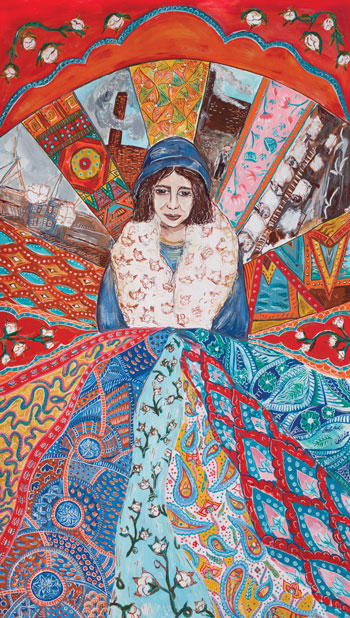
About the image
A series of 3 Images created by Lizzie Rigby, the main inspiration behind the style of these paintings comes from the artwork of the 'shippers tickets' beautiful peices of art which were created for the northern textile companies to entice foreign buyers in India and China. British Artists created beautiful original interpretations of Indian scenes and motifs. See http://www.textiletrademarks.com/ for in-depth knowledge on bolt label art from Adrian Wilson, from Ashton Under Lyne. This image 'Cottonopollis Queen' is Inspired by a photograph of the Cotton Queen for Hyde in 1930, Frances Burgess. Central in Cottonopollis, surrounded by industrial imagery and holding textiles of the world. Textiles from Africa influenced by prints designed in Hyde by company ABC wax. Also textiles from India of which we use when creating puppets and costume today, textiles flowing through time.
About the artist
Lizzie Rigby Lizzie Rigby is a freelance artist based in Mossley, she has worked as a maker, stilt performer, workshop facilitator for Global Grooves and other organisations for the last 4 years. Lizzie has produced work: puppets, costumes, flags for many festivals and carnival parades. Obviously, in the last year, there haven't been many of them, so Lizzie has been developing her design and painting skills and exploring elements of her creative craft.
Contact:
Dancing Morris

About the image
A series of 3 Images created by Lizzie Rigby, the main inspiration behind the style of these paintings comes from the artwork of the 'shippers tickets' beautiful peices of art which were created for the northern textile companies to intice foreign buyers in India and China. British Artists created beautiful original interpretaions of Indian scenes and motifs. This image 'Dancing Morris' is Inspired by Local Morris; a visual representation of the heritage, showing the connection through dance and costume which will eminate from this building for years to come. Local Morris Man, Martin Stimpson tells us more about this heritage here.
About the artist
Lizzie is a Visual Artist based in Mossley and has been working for Global Grooves for the last 4 years as a maker, Stilt performer and workshop facilitator. She has been involved in creating puppets and costume for many festivals and Carnival parades. Obviously over the last year there hasn't been many of those, so Lizzie has been developing her design and painting skills and exploring elements of her creative craft.
Contact
Batik blue

About the Image
The batik is hand painted for Cabasa Carnival arts, by artists Kate Rothery and Dan Jones on Indian silk. Batik originates from Indonesia and was introduced to West Africa in late 19th Century. It uses wax as a resist to the dye and when hand made produces a unique piece. The silk is hand-woven, heritage grade from Murshidabad, W. Bengal. The design references images from the other pieces in the exhibition and motifs used by ABC Wax in Hyde. The design celebrates Carnival and is inspired by the different cultures in Tameside and its significant textile heritage. George Lawton and Sons, award winning flannel manufacturers, produced award winning cloth from The Vale which incorporated silk to give a lustrous feel and less shrinkage in 1860s. Read more here
Emily loves the way the silk take the dyes and produces a delicate yet incredibly durable pieces for carnival in the UK.
About the artist
Emily Wood is Artistic Director and CEO of Manchester (UK) based Carnival arts organisation Cabasa Carnival Arts CIC. Since its creation in 2009 the company has gone from strength-to-strength with Emily at the helm, producing large, spectacular outdoor work, turning the streets into a stage. From high-profile commissions and productions such as ‘Small Is Beautiful’ Trinidad & Tobago 2017, 'The Great Garden Carnival' for RHS Tatton Flower Show and ‘The Olympic Heroes Parade’ 2016, her work has been showcased and toured to huge audiences across the UK and internationally.Since founding Cabasa, Emily has already made huge leaps towards realising her vision of using the traditional methods of costume development and fabrication to broaden the impact and appeal of Carnival artistry in the North West of England in particular. Her work has gained national and international acclaim and regularly works with other Carnival & outdoor production companies such as: Global Grooves, Kinetika, Walk The Plank, and Notting Hill Carnival. She has a team of skilled artists and makers based in Manchester, and regularly provides opportunities for up-and-coming talent interested in Carnival, as well as sharing her skills and passion for the art form with the local community.
Emily's work has always been informed, inspired, and deeply rooted in traditional and folkloric styles of Carnival, in particular Candomblé (an Afro-Brazilian religion) and the traditional characters of Trinidadian Carnival, delving into their social and political impact around the world and re-telling stories for a 21st Century audience.
Contact:
Batik Red

About the image
The batik is hand painted for Cabasa Carnival arts, by artists Kate Rothery and Dan Jones on Indian silk. Batik originates from Indonesia and was introduced to West Africa in late 19th Century. It uses wax as a resist to the dye and when hand made produces a unique piece. The silk is hand-woven, heritage grade from Murshidabad, W. Bengal.
The design references images from the other pieces in the exhibition and motifs used by ABC Wax in Hyde.
The design celebrates Carnival and is inspired by the different cultures in Tameside and its significant textile heritage. George Lawton and Sons, award winning flannel manufacturers, produced award winning cloth from The Vale which incorporated silk to give a lustrous feel and less shrinkage in 1860s. Emily loves the way the silks take the dyes and produces a delicate yet incredibly durable pieces for carnival in the UK.
Emily Wood is Artistic Director and CEO of Manchester (UK) based Carnival arts organisation Cabasa Carnival Arts CIC. Since its creation in 2009 the company has gone from strength-to-strength with Emily at the helm, producing large, spectacular outdoor work, turning the streets into a stage. From high-profile commissions and productions such as ‘Small Is Beautiful’ Trinidad & Tobago 2017, 'The Great Garden Carnival' for RHS Tatton Flower Show and ‘The Olympic Heroes Parade’ 2016, her work has been showcased and toured to huge audiences across the UK and internationally.Since founding Cabasa, Emily has already made huge leaps towards realising her vision of using the traditional methods of costume development and fabrication to broaden the impact and appeal of Carnival artistry in the North West of England in particular. Her work has gained national and international acclaim and regularly works with other Carnival & outdoor production companies such as: Global Grooves, Kinetika, Walk The Plank, and Notting Hill Carnival. She has a team of skilled artists and makers based in Manchester, and regularly provides opportunities for up-and-coming talent interested in Carnival, as well as sharing her skills and passion for the art form with the local community.
About the artist
Emily's work has always been informed, inspired, and deeply rooted in traditional and folkloric styles of Carnival, in particular Candomblé (an Afro-Brazilian religion) and the traditional characters of Trinidadian Carnival, delving into their social and political impact around the world and re-telling stories for a 21st Century audience.
Contact:
Girl Sitting

About the image
Girl Sitting I started with an image in my mind of a little girl sitting inside a window frame with a mysterious, thoughtful expression. I wanted to create a bold cross cultural image and selected some creative commons free copyright wax prints from the Hyde company ABC Wax. I discovered that the designers created patterns used to make cloth for customers in West Africa, The technique is Javanese in origin. The print the little girl sits on reminded me of an electronic diagram or a bird's eye view of a modern metropolis. The other print is the company's eponymous textile. I sat the black and white girl in-between these bold colourful prints with a blank cotton whiteness between them that can be read in different ways by the observer, does it represent a fresh blank sheet or something erased?
About the artist
Mel Roberts, Visual Artist I make things and am a freelance visual artist, facilitator at Leeds Medical Institute and associate artist at Global Grooves, with extensive experience and love of carnival arts, integrating creative technologies and exploring materials. More recently it has been a joy to work with colleagues and volunteers again on creative projects. I also do children's parties.
Contact:
Girl Standing

About the image
My starting point was a striking photograph taken at Carr Hill Mill, Mossley, which was destroyed by fire in 1897. The card room girls in the photo probably made shirtings for British soldiers in India and China. They had very low status, ofter taunted for the cotton 'fluff' that attached itself to them. The girl is both crudely pixelated and hand drawn in a surmised sharper focus; we will never know her name, but to me she looks out at us with attitude! Behind her is an altered wax print of a staircase, designed in Hyde. I chose it to resonate with The Vale's exterior victorian staircase. There is also a nod to Millstone Brewery – a 1970's wax textile of a roller-skate with millstones for wheels!
About the artist
Mel Roberts, Visual ArtistI make things and am a freelance visual artist, facilitator at Leeds Medical Institute and associate artist at Global Grooves, with extensive experience and love of carnival arts, integrating creative technologies and exploring materials. More recently it has been a joy to work with colleagues and volunteers again on creative projects. I also do children's parties.
Contact:
Northern Spinster
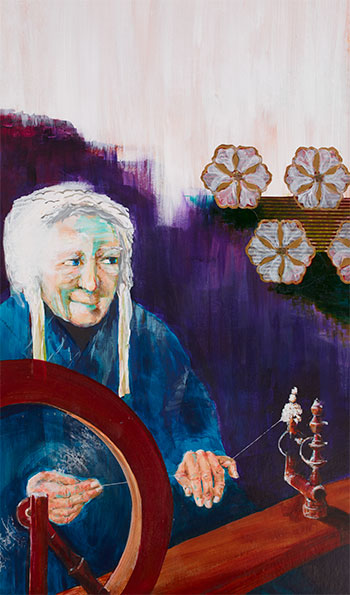
About the image
I chose to paint an old lady smiling past her spinning wheel towards the other depictions of cotton culture. Mossley has many old weavers cottages, built in a pre-industrial era of mainly female spinning and weaving. In my experience Mossley has the perfect climate for spinning cotton, pretty wet! This is shown on the artwork as an oppressive low cloud – it doesn't put my sparky old lady off though! I enjoyed creating a looser style with acrylics and collage in this piece and in G5, Indian Spinner.
About the artist
Mel Roberts, Visual ArtistI make things and am a freelance visual artist, facilitator at Leeds Medical Institute and associate artist at Global Grooves, with extensive experience and love of carnival arts, integrating creative technologies and exploring materials. More recently it has been a joy to work with colleagues and volunteers again on creative projects. I also do children's parties.
Contact:
Indian Spinner

About the image
Indian Spinner. On this panel I wanted to think about the trade connections between India and Britain. The most elementary way I could imagine was a thin thread of cotton, a line through time. The Indian lady pinches the thread in a classical Indian dance gesture meaning swan beak, the thread re-appears in the panel Northern Spinster. An Indian spinning wheel, the Charkha, can be seen in the background. The charkha became a powerful symbol of Gandhi's campaign for Indian home rule, I discovered that he advocated producing homespun cotton to replace imported textiles from Britain. An ABC Wax print of flowers is used as an imagined colourful archway in the window frame of this dark satanic mill.
About the artist
Mel Roberts, Visual ArtistI make things and am a freelance visual artist, facilitator at Leeds Medical Institute and associate artist at Global Grooves, with extensive experience and love of carnival arts, integrating creative technologies and exploring materials. More recently it has been a joy to work with colleagues and volunteers again on creative projects. I also do children's parties.
Contact:
Cotton Queen 1

About the image
Inspiration for three queen images is carnival, large scale puppets and industrial queens who were crowned ambassadors for their industry such as cotton, coal, railway, wool. This tradition was popular in the early twentieth century. Depicted is a Cotton Queen of Bangladeshi heritage. Many families from Bangladesh were encouraged to come to the UK in the 1960s to support and maintain the cotton industry in towns such as Mossley. The scene also shows people in costumes that relate to the cotton industry such as the spinning jenny, cotton bolls, bobbins and cotton pickers.
Manchester Guardian Newspaper, July 1930 reported on a Cotton Carnival in Mossley with a mile long procession watched by thousands and attended by the British Cotton Queen Frances Locket from Hyde.
Artist - Sue Watling
Contact:
Cotton Queen 2
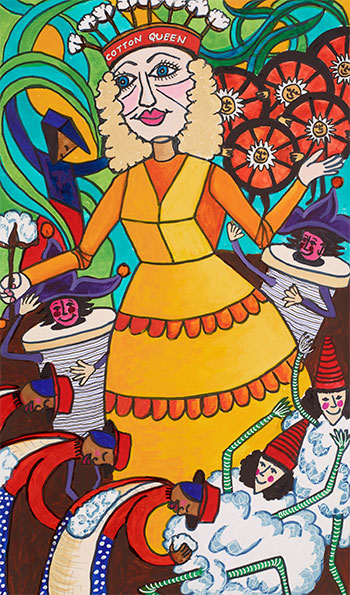
About the Image
The Rose Queen
Ideas for this scene came from carnival, large scale puppets, the crowning of a Rose Queen at the churches' May Day festivals. The Rose Queens and Cotton Queens became interwoven over time. So I have linked the two showing a carnival scene with related costumes , cotton bolls, bobbins , spinning jennys and cotton pickers.
According to Manchester Guardian July 14th 1930, ' Mossley celebrates cotton queens' Mossley held a Cotton Carnival. A mile long procession and a carnival in the technical school in the evening was enjoyed by many. The British Cotton Queen, Frances Locket from Hyde took part in the parade.
Artist - Sue Watling
Contact:
Cotton Queen 3

About the image
I wanted to mark the importance of the African diaspora in the initial process of the cotton trade. The scene above is one of carnival, dance and costume. The cotton mills of Mossley gave me ideas for the cotton boll dancers, Spinning Jennys and the turning bobbins.
During the American Civil War 1861 - 1865 Lancashire cotton workers faced financial hardship as raw cotton was blockaded in the Southern Ports. Accounts in the newspapers speak of terrible poverty and starvation in Mossley but still many mill workers stood in solidarity with enslaved cotton workers and fighting for freedoms for all. As a major centre of cotton cloth production Manchester and areas President Lincoln thanked the workers for their support.
Artist - Sue Watling
Contact:
Sivaji the puppet having a ball

About the image
Sivaji, a puppet inspired by a famous Indian movie star glows in Blackpool's glorious ballroom. Sivaji is whisking dancer Freya round the floor, showing her dress to fantastic effect.
The dancer's costume is inspired by Brazilian folkloric styles. It's made from silk and cotton and was hand made in Vale Mill. More than a century earlier workers in the mill also used silk and cotton from Asia to produce award winning textiles. We love it that an invisible thread links the heritage of the mill with 21st Century carnival!
Contact Global Grooves
Photo: Greg Wolstenholme
Costumes: Cabasa Carnival Arts
Puppet design: Iola Weir
The Bloco

About the image
The image is the Global Grooves bloco, inspired by Brazilian carnival street bands which bring music, movement and energy to excite the crowd.
The Global Grooves bloco is comprised of dancers, drummers and of course brass - in the town famous for National Brass Band Competition, there has to be brass!
The Carnival event is the finale of a process of many months behind the scenes activity. The Global Grooves Bloco costumes above were made in partnership with Cabasa Carnival Arts and many hours of volunteers.
Contact: [email protected]
Photo: C Dyson
Costumes: Cabasa Carnival Arts
Yansa

About the image
Dancer Bridget performs the Orixá Yansa. Orixá is a Yoruban word meaning 'an expression of divine self'. Orixás (there are many) represent different human archetypes and characters of the natural world. Yansa's symbol is the tornado, a fierce bringer of change and swift transformation. This tradition travels through the descendants of the African diaspora across South America and beyond.
This image captures the movement and energy brought to the streets in a production by Global Grooves and Cabasa Carnival Arts. Town carnivals in NW England are an important part of local heritage, being one of the key events for people with modest homes and incomes to enjoy. On the street neighbours become friends and a sense of community prevails. You can listen to a lifetime Mossley resident speak about carnivals and the importance of community here. At their best and most relevant to new audiences Carnivals can be respectfully inspired by diversity, breathe life into town centres, spread joy and connect neighbours to community.
Contact:
Costume: Cabasa Carnival Arts
Photo credit: C Dyson
Puppet Constance

About the image
Constance elder is the remaining puppet of 3 created for Mossley Light Festival 2016 to celebrate Mossley's heritage as an industrial mill town. * Mossley's transition from small, wet boggy area to a thriving mill town and then digitally connected commuter town was depicted in young and mid-life Constance in an illuminated carnival.
Made by local artists and volunteers Constance combined the lantern parade tradition with a winter carnival to transform the November streets with light, energy and wisdom.
* The other two Constance puppets were stored in Ray Mill, Stalybridge. Ray Mill was built in 1908 to spin cotton and destroyed in 2018 by fire. Sadly, fire has always been a threat to mills, Vale Mill was partly destroyed by fire in 1933, click on The Vale image on this site to find out more.
Contact
Credit
Photo C Dyson
Millstone Brewery

Studio 1

A beautiful, welcoming space flooded with natural light and equipped to inspire creativity. There's a dedicated cutting and sewing room, rooms to dye and steam fabric. A wellbeing area caters for body and soul because every carnival process needs cake!
It's a far cry from the dusty, noisy and dark conditions Vale Mill workers had to endure during the 19th and early 20th Century.
The Venue

The venue is a fabulous space for live music, theatre, dance and cinema. With a maximum capacity of 300, a well stocked bar, our own ale from Millstone Brewery and a wonderful energy it's guaranteed to be a great evening. We'll offer the best in diverse arts and culture with an exciting programme.
The Yard
An open workshop space when the weather permits and containing a Carnival garden, the yard will adapt to the needs of its users and the seasons. Sited within the boundaries of the original Vale Mills collection of buildings you can see evidence of the engineering that the mill needed (supplies of water from a mill lodge etc.) We plan to have an electric car charging site in this area when funding permits.
Within the yard area is the shed, a dirty workshop area for welding and fabrication processes that are a key part of our puppet construction.
The Vale
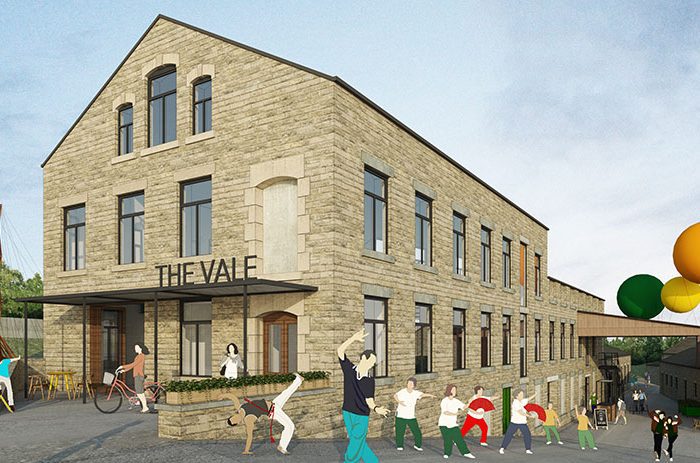
Vale mill's heritage is a key part of Mossley's earlier successful textile industry. Constructed in 1793 on Micklehurst Brook by Benjamin Mellor, Vale Mill was part of a collection of mills on the site. Extended in 1803 to 4 storeys high, rebuilt and extended over the years by George Lawton and Sons, woollen and flannel manufacturers, it's one of the few remaining mill buildings in Mossley.
George Lawton's award winning cloth was even used to make Queen Victoria's knickers! See more here. In 1910 it held 3,600 spindles and 58 looms for making flannel and wool for domestic and export markets.
Vale Mill suffered a fire in 1933 which started from the 3rd floor and destroyed most of the roof, the spinning, weaving and carding departments. You can see the difference in roof height today.
The mill was sold by auction in 1938 and was then home to a variety of local business.
Global Grooves moved into part of the site in 2014 and in 2020 started a project to maintain the building's heritage and make it inviting for modern use.
The Vale mill building is now a state-of the art Carnival centre of excellence. Textile industry fortunes have shifted so that we now import silk and cotton from India and China for our hand made costumes. A 21st Century twist in the story of Vale Mill that we suspect our predecessors would find surprising, given Mossley was one of the 10th most important towns in the cotton spinning industry. For a detailed talk by Bill Westhead on the rise and fall of the industry in Mossley see here.
Now transformed from a draughty, badly lit cold space to a modern, welcoming space where creativity flows we invite you to come along, take a look and get involved!
Welcome to The Vale
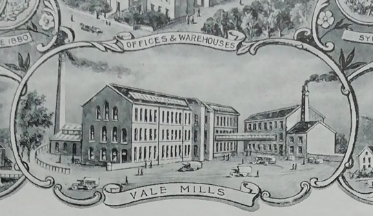
Welcome to Vale mill, a former textile mill. As you've stepped through our virtual door we extend the warmest of welcomes and thought you might want to know a little more about the building. It's one of the only remaining mills in the town still involved with textile processes.
Vale Mill was an important part of the Micklehurst wool industry (which pre-dates the cotton industry) and used using local sheep breeds such as Lonk and Derbyshire Gritstone to provide fleece for processing. Most of the wool industry was done in the home, with wool mills concentrating on initial 'fulling' and 'scribbling' processes. Vale Mill was erected by Benjamin Mellor in 1793 intended for use in the woollen industry. It went on to be used also for textile printing and cotton spinning by various occupants. In 1803 the building was extended to four stories and rebuilt in 1847 when it was occupied by Messrs George Lawton. Between 1825 and 1835 Mossley reduced its working wool mills from 16 to 10. When other wool mills closed, Vale mill expanded, invested in machinery to be competitive and offer quality. By 1910 under occupancy of Messrs George Lawton it contained 3600 spindles and 58 looms who produces plain and fancy flannels, cashmere flannels, suiting, silk and wool shirtings and more. ( flannel was made from fine wool and shirtings were fabric used to make shirts/tops).
Messrs Lawton occupied the mill for over 100 years and their products won gold awards at international trade fairs and exhibitions in 1851 in London, Paris 1867, and Sydney 1880. These events were great showcases of high quality work and covered all aspects of industry and art. Read more here. Lawton's workers produced such fine work that according to The Reporter, March 1937 it was worn by Royalty, or as we like to say, they made Queen Vic's Knicks!
Unfortunately fires were a regular threat in mills, the combination of fibres, oils and high temperatures was a high risk and unfortunately in 1933 a fire started on the 3rd floor destroyed the spinning, weaving and carding departments and most of the roof of Vale Mill making 130 employees out of work.
Most of the remaining buildings are 19th Century with what might be a small weavers shed remaining from 18th Century. In 1938 the mill was sold at auction. Since then it has been put to different uses such as, glove making, and a mixture of small business.
Vale Mill provided a livelihood for many people as a textile mill for more than a century. It's survived the ups and downs of the textile trade and competition with the cotton mills which grew to dominate the town until lack of investment and competition from abroad resulted in the decline of a major industry for the town.
The Vale is still connected to textiles and skilled work through our carnival work and is providing employment and opportunities for creativity and excellence in Carnival arts.
Cakes and the grand parade 1892
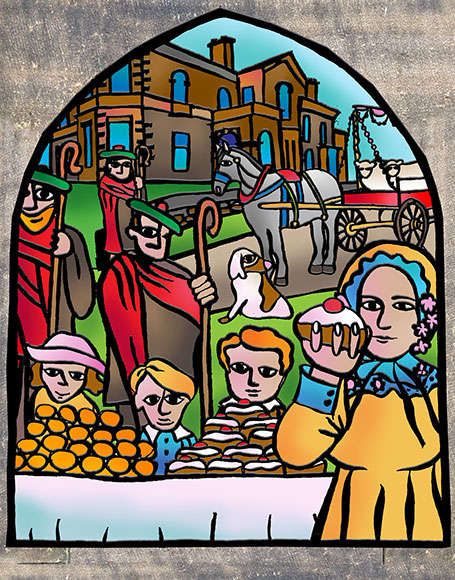
About the image
Mossley Heritage trails were the inspiration behind Ann’s panels which reflect Mossley’s long legacy of parades and celebration. This panel commemorates the grand parade in 1892 that celebrated Whitehall, becoming Mossley’s new Town Hall. The house had been built by mill owner George Mayall for his wife, but she died before she could move in. The house had been sold to the Town Council for £4000 less than the cost of the ornate fireplace in the house. There was a mile long parade own Stamford street with over 4000 people in it. There were seven bands and the Ancient Order of Shepherds (who were not really shepherds but a friendly society who were a precursor to the NHS) were dressed in their robes with a wagon in the shape of a sheep pen complete with lambs and a sheep dog. The mayoress gave out 4000 buns and oranges to the children and asked that in return they never do any damage to the trees and flowers around the Town Hall or stand around and see others do damage.
About the artist
Ann Gilligan grew up in Saddleworth and now lives in Mossley. She has a first-class degree in Fien Art where she trained as a sculptor.
Better known as Green Monster Arts, has worked as a freelance artist since then in a broad range of materials including cast stone, mosaic, metal, wood, recycled materials and painted and digital murals. She specialises in public and community art, working with people to improve their neighbourhoods and feel more connected to their environment and local community.
In 2019 Ann set up Phantasmoagoria Magic Travel Emporium, an arts hub in the centre of Ashton with a focus on using creativity for wellbeing. She has a particular interest in history and heritage and worked with Mossley Civic Society and the 5 local primary schools to create The Mossley Heritage Trails. They run from each school to Mossley Heritage Centre taking you on a journey through Mossley's fascinating history.
Contact:
Elephants in Mossley
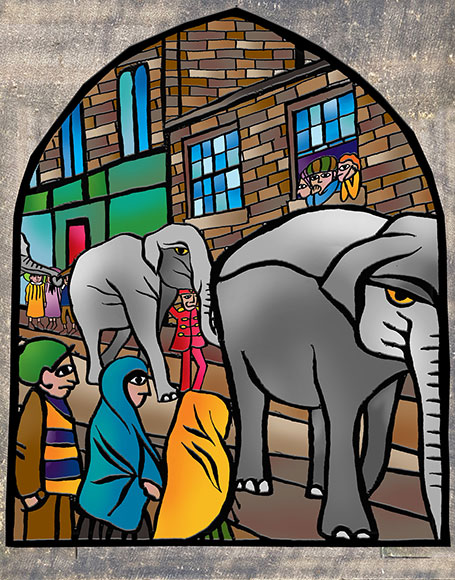
About the image
This image is based on a photograph of a parade of elephants from Sanger’s circus marching along Manchester Road around 1910. So many children wagged off school to see the parade circus days were declared a half day holiday. An article from the time about All Saints School says “When Sanger’s Circus was in town the school closed for the afternoon”. Ann particularly wanted to depict the elephants as they seem to be something of a tradition in Mossley. In more recent times she designed the Mossley Mammoth hunts for the Marvellous Mossley Great Community Get Together working with local schools and community groups. Elephants also popped up here at The Vale in the form of the Spice Girls – Global Grooves very own giant elephant puppets and as a beautiful, illuminated lantern in the Mossley Light Parade. They may not actually be live ones anymore but there is definitely something about Mossley that attracts pachyderms!
About the artist
Ann Gilligan grew up in Saddleworth and now lives in Mossley. She has a first-class degree in Fine Art where she trained as a sculptor. Better known as Green Monster Arts, Ann has worked as a freelance artist since then in a broad range of materials including cast stone, mosaic, metal, wood, recycled materials and painted and digital murals. She specialises in public and community art, working with people to improve their neighbourhoods and feel more connected to their environment and local community. In 2019 Ann set up Phantasmagoria Magical Travel Emporium, an arts hub in the centre of Ashton with a focus on using creativity for wellbeing. She has a particular interest in history and heritage and worked with Mossley Civic Society and the 5 local primary schools to create the Mossley Heritage Trails. They run from each school to the Mossley Heritage Centre, taking you on a journey through Mossley’s fascinating history. It is these trails that were the inspiration behind Ann’s panels which reflect Mossley’s long legacy of parades and celebration.
Contact:
Junk Jam
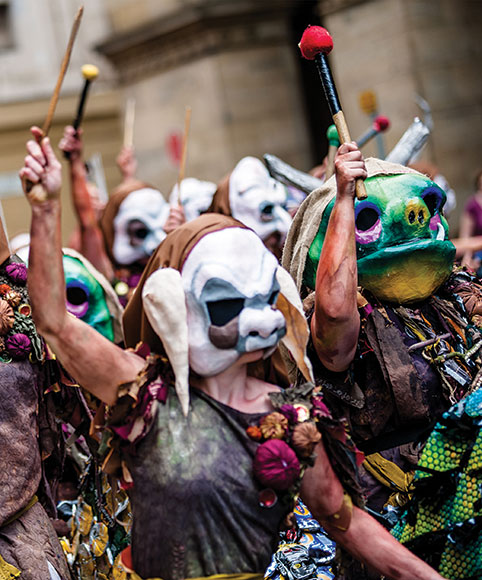
About the image
Junk Jam was the first Carnival production created by artists and volunteers in Vale Mill 2012. It used mostly recycled materials, including shopping trolleys, previously used costumed, tea bags, crisp packets etc inventively to create a stunning award winning piece of community Carnival. Drama, provocation and powerful percussion combined with energetic choreography and call and response song. Junk Jam took the key elements of Carnival and shook them up with a fiery twist. Carnival doesn't happen unless people come together to make it happen and to take to the streets to celebrate. We know that workers in Mossley and those at Vale Mill made the most of the little leisure time they had during Wakes weeks and carnivals and processions where people gathered outside of the home was a key part of being part of a community. Carnival brings art to public spaces and we think that the workers who lined the streets in the 19th Century would share our impulse to keep the tradition going, even if for different times.
Credits:
Image - C Dyson photography
Masks - No Eyed Theatre
Rosemary Ripple and Giant African land snail

About the image
Say hello to Rosemary Ripple and her Giant African land snail.
Local Carnival heritage often involved riding a decorated wagon or young women sat aloft a car decorated with paper flowers. Local businesses and mills would send out a decorated float for the town Carnival. Our collection of electric powered gastropods offer an eco-friendly Carnival ride fit for our times. Children and the young at heart enjoy the dipsy joy they bring to modern Carnival. When they're at rest, our gastropods, which also glow in the dark, sleep happily in their shells waiting for their riders to race, ready, steady.....slow...
Credit
Costume: No Eyed Theatre
Design: Tony Mason
Photo: Scott Salt
Bessemer
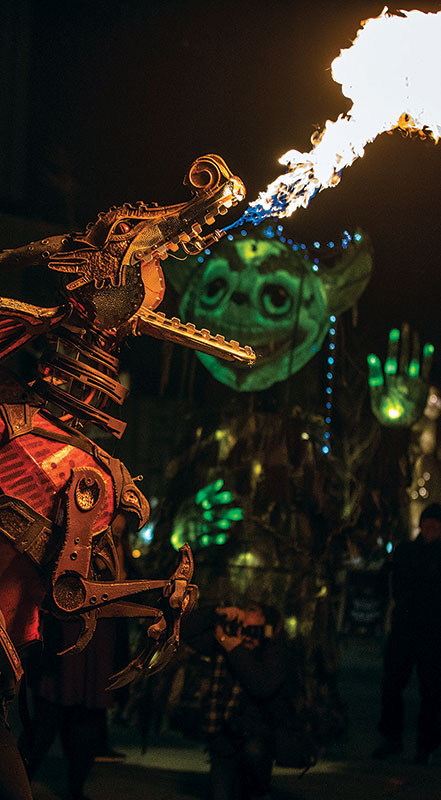
About the image
Bessemer or Bessie is our fire breathing dragon. Created after a fire in Ray Mill, Stalybridge, that destroyed our stored puppets. Here the artist has reinterpreted fire in Bessemer who clears the way and brings positive energy to the streets.
Fire has always posed a high risk in textile mills due to the flammable nature of the fibres and types of machinery. In 1933 a fire partly destroyed Vale Mill and put 130 people out of work, or 'made idle', as the newspaper reported it. Britannia Mill, Manchester Road Mossley, was one of the largest cotton spinning mills in the world until it was ravaged by fire in 1860 before being rebuilt by mill owner Mayall. You can read more about this tragic Mossley event in a historical narrative produced by Megan here.
Bessie reflects the best in bringing local volunteers together to work with a lead artist to create something innovative and exciting. We hope the workers of George Lawton and Sons, our predecessors, would be heartened by the bridling of fire for positive use almost 100 years after their losses.
Credit
Photograph: Alan Hamer
Design Tony Mason
IOLA 2

About the image
Iola 2 is a super tech puppet using the latest mobile illumination technology and expertise within the Global Grooves family. Iola is a great example of work that keeps Carnival traditions alive while pushing creative boundaries to excite modern audiences. It seems our our innovation connects us to the heritage of the mill and its workers. As a former site producing internationally award winning flannel and wool for more than one hundred years (up to 1930s) it was a specialist in its field. At a time when the wider woollen industry in the town was declining in C19th, George Lawton and Sons of Vale Mill, invested in new methods and mechanisation to remain successful. Read more here.We hope our predecessors would appreciate that the site they helped to make successful continues to thrive.
Credit:
Designer: Iola Weir
Photo: Simon Webb
